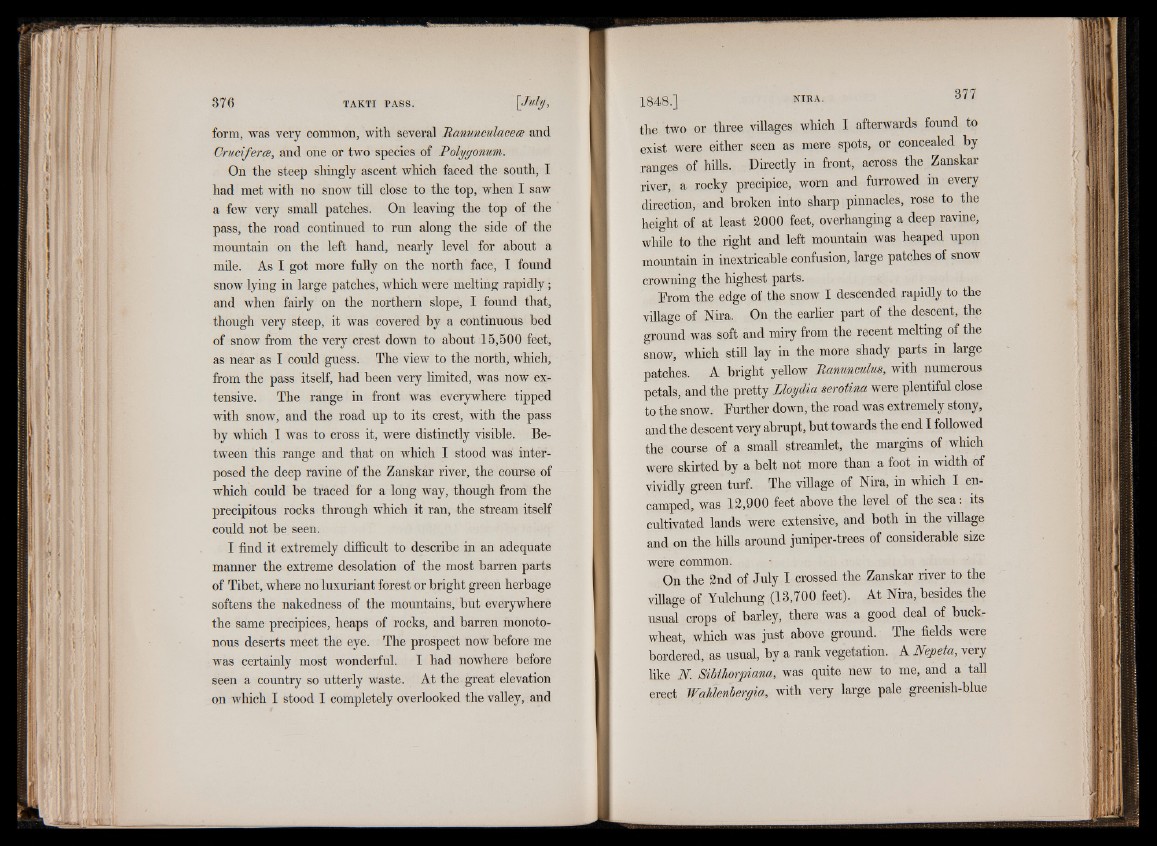
form, was very common, with several Panunculacece and
Crucifercb, and one or two species of Polygonum.
On the steep shingly ascent which faced the south, I
had met with no snow till close to the top, when I saw
a few very small patches. On leaving the top of the
pass, the road continued to run along the side of the
mountain on the left hand, nearly level for about a
mile. As I got more fully on the north face, I found
snow lying in large patches, which were melting rapidly;
and when fairly on the northern slope, I found that,
though very steep, it was covered by a continuous bed
of snow from the very crest down to about 15,500 feet,
as near as I could guess. The view to the north, which,
from the pass itself, had been very limited, was now extensive.
The range in front was everywhere tipped
with snow, and the road up to its crest, with the pass
by which I was to cross it, were distinctly visible. Between
this range and that on which I stood was interposed
the deep ravine of the Zanskar river, the course of
which could be traced for a long way, though from the
precipitous rocks through which it ran, the stream itself
could not be seen.
I find it extremely difficult to describe in an adequate
manner the extreme desolation of the most barren parts
of Tibet, where no luxuriant forest or bright green herbage
softens the nakedness of the mountains, but everywhere
the same precipices, heaps of rocks, and barren monotonous
deserts meet the eye. The prospect now before me
was certainly most wonderful. I had nowhere before
seen a country so utterly waste. At the great elevation
on which I stood I completely overlooked the valley, and
the two or three villages which I afterwards found to
exist were either seen as mere spots, or concealed by
ranges of hills. Directly in front, across the Zanskar
river, a rocky precipice, worn and furrowed in every
direction, and broken into sharp pinnacles, rose to the
height of at least 2000 feet, overhanging a deep ravine,
while to the right and left mountain was heaped upon
mountain in inextricable confusion, large patches of snow
crowning the highest parts.
From the edge of the snow I descended rapidly to the
village of Nira. On the earlier part of the descent, the
ground was soft and miry from the recent melting of the
snow, which still lay in the more shady parts in large
patches. A bright yellow Ranunculus, with numerous
petals, and the pretty Iloydia serotina were plentiful close
to the snow. Further down, the road was extremely stony,
and the descent very abrupt, but t owards the end I followed
the course of a small streamlet, the margins of which
were skirted by a belt not more than a foot in width of
vividly green turf. The village of Nira, in which I encamped,
was 12,900 feet above the level of the sea: its
cultivated lands were extensive, and both in the village
and on the hills around juniper-trees of considerable size
were common.
On the 2nd of July I crossed the Zanskar river to the
village of Yulchung (13,700 feet). At Nira, besides the
usual crops of barley, there was a good deal of buckwheat,
which was just above ground. The fields were
bordered, as usual, by a rank vegetation. A Nepeta, very
like N. Sibthorpiana, was quite new to me, and a tall
erect Wahlenbergia, with very large pale greenish-blue